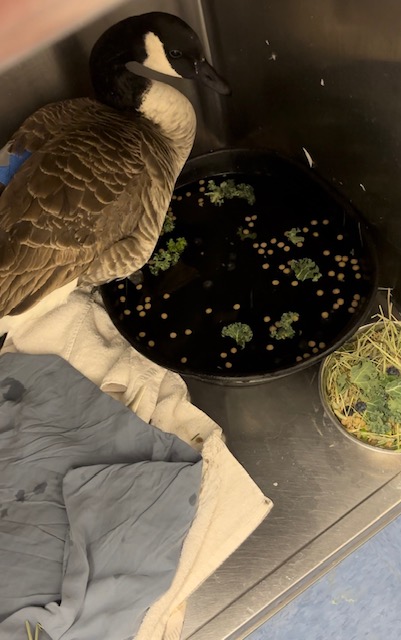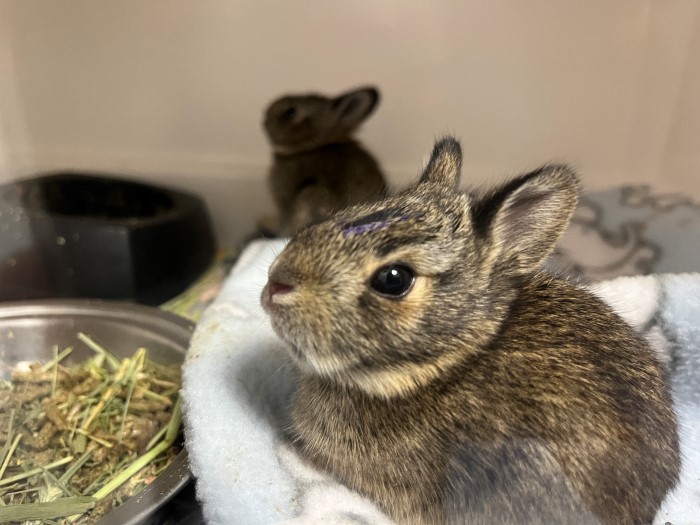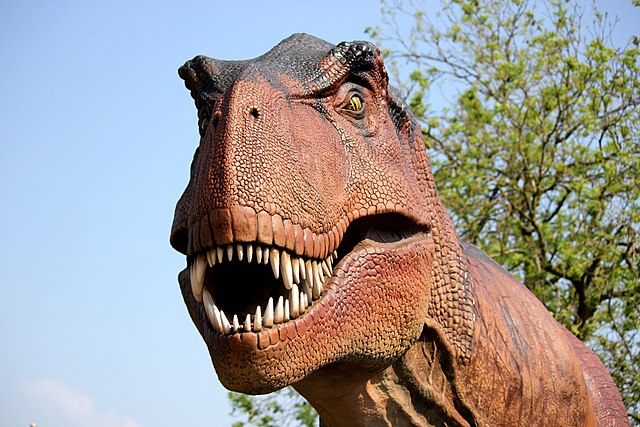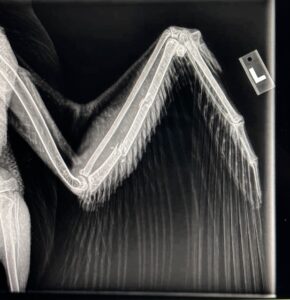
Last month an adult Canada Goose presented to the Wildlife Medical Clinic after unfortunately being struck by a car. It was examined by one of our veterinarians and found to have a fractured ulna (a major bone in the wing), a fracture on the gnathotheca (the bottom part of the bill), a multitude of eye issues, as well as parasites, and some superficial lesions. The ulnar fracture was further evaluated through radiographs, and it was determined that a wrap could be placed to stabilize the fracture. This is because the other bone next to the ulna, the radius, was fine. The radius would provide support and ensure the ulna stays in place during the healing process. The goose was also given eyedrops and two anti-parasite medications, in addition to having an eye exam scheduled with a veterinary specialist.
This patient came into the clinic over our Spring Break. Because of this, the clinic needed volunteers to step up to take over as primaries and secondaries for the various cases (one of each per case) that came in while most students were away on break. Becoming a primary means that you are the first contact if there is an issue, or if anyone has questions or concerns. In addition to that, you are the main person making medical decisions with guidance from veterinarians. To do this, you must know the case inside and out and be up to date with changes. While this may be time consuming, the knowledge and experiences gained are invaluable. As a first-year vet student I immediately jumped at the opportunity to become primary on a complex case like this, because there is no better way to learn than through hands-on experience.
In terms of treating the goose, we continued the prescribed medication and began to start PROM, which stands for passive range of motion. PROM is something we do in birds that have undergone a traumatic injury to their wings, such as a fracture. Since the birds do not use their wings as much and are not able to fly while hospitalized at the clinic, it is important to try to minimize the effects of not using the wing, especially while healing. This is basically the same concept as physical therapy in humans. To do this, we sedate the bird and carefully extend the wing joints for multiple sets, working towards the range of motion that the unaffected wing has. If this is not done, then the joints can become too stiff, decreasing the birds’ chance of release, and release is the ultimate goal for all our patients.
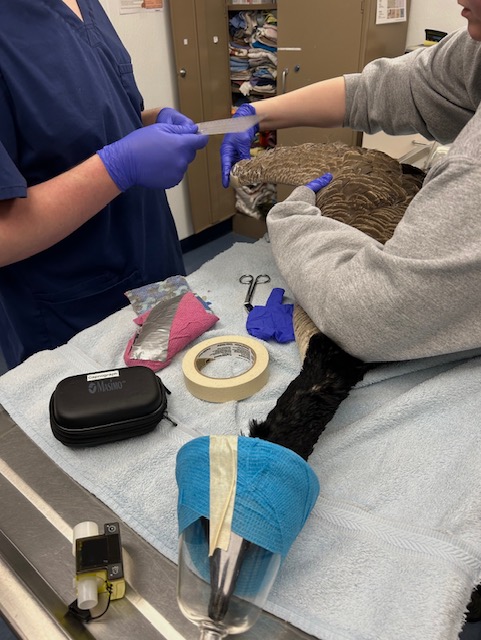
When caring for geese and other waterfowl it is important to ensure that their enclosure is well padded. Since they don’t perch like raptors such as hawks and owls, the floor must be well padded to prevent foot issues. With all birds, but especially waterfowl, it is extremely important to maintain their feathers, since damage to them can affect the waterproofing that is needed to survive. To do this we would ideally handle them as little as possible, but if handling is needed, we instead use a sheet or towel to safely restrain the goose. This, hopefully, minimizes damage occurring to the feathers while we have them in hand. Additionally, it is important to provide a large area of water where they can sit and eat. Unfortunately, we do not have large pools available and therefore do not like to hold waterfowl long term, unless we absolutely have to. While we can meet their needs and make do with what we have, it is best when we can provide them with more space. One other issue we faced was weight loss, as this individual did not want to eat. We made the decision to tube feed with a special diet to get its weight back up but continued to offer a regular diet as well, in hopes that it would start eating more on its own.
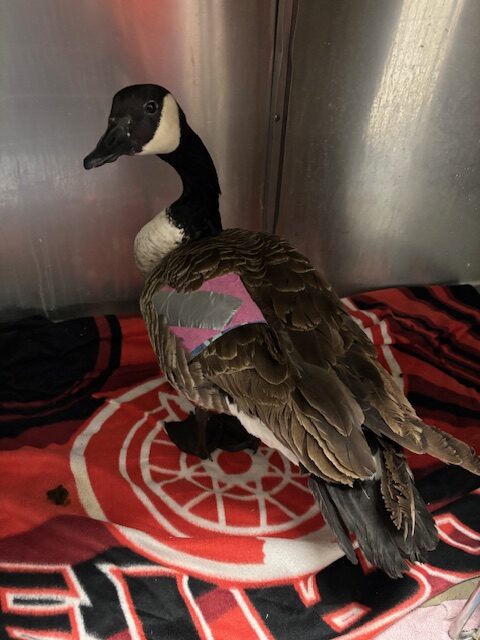
Once the goose stabilized and was healing well, we were able to transfer the patient to another licensed rehabilitator, that does have a larger area to hold waterfowl long term until release is possible. In addition to having plenty of space, they also had other geese that this patient could socialize with while continuing to recover. Both fractures in this goose stabilized on their own, while the eye issues and parasites were resolved thanks to medication and time. Now that the goose has a larger space available and other waterfowl to socialize with, hopefully it will thrive and return to a normal life in the wild.
“When I first came to the University of Illinois Urbana-Champaign, I already had plenty of experience with birds, but I wanted to continue to learn about the anatomy, behavior, and caretaking of as many birds as possible to further my goal of becoming a zoo veterinarian. So, when I saw that there was an opportunity to work with a Canada Goose—which is a species I have not previously worked with—I knew I had to take it. Especially with the injuries and issues it had as I’d never encountered these before and wanted to learn more about how we treat them. I elected to become a secondary, this mainly entailed me helping to take care of the goose’s injured wing and the goose’s husbandry, which is how it was housed and what it ate while we had it in our care. When it came to its wing, I was able to learn about and practice how to measure the angle of a wing while it was being extended, how to best stretch a wing gently enough so that it wouldn’t be strained, and how to wrap and bandage a wing so that its feathers weren’t damaged from the wrap being too tight while still being tight enough to restrict movement. I also was able to learn different methods of restraint, methods for administering medication, proper housing needs, all about their dietary needs and how to provide supplemental feedings and was able to observe the goose’s behavior.”
~Jack
“Being primary on this complex case has taught me so much that I could’ve never learned in the classroom. This is a completely unique experience, especially for a first- year student. I really enjoyed taking on a leadership role with this case and working so closely with our veterinarians to see how things work behind the scenes. Whether it was determining types of medication, analyzing avian radiographs, or just learning how to treat and manage an injured animal, the experiences I’ve had will help me drastically in my future as a veterinarian. Not only have I gained knowledge, but confidence as well. Going into the case I was unsure how ready I was to handle being primary. However, thanks to the guidance of the managers and veterinarians I felt comfortable and now know that I could do it again. Having this much input with a patient as a first-year vet student is an experience unique to the Wildlife Medical Clinic, and it is something I would highly recommend to anyone interested in working with animals. While you might not feel ready, the only way to truly find out and become comfortable is to take the initiative and try. As I said before, the best way to learn is through experience and with experience comes confidence and a higher level of comfort with the task at hand.”
Dylan
This was written by Dylan and Jack, WMC Volunteers, Class of 2027

